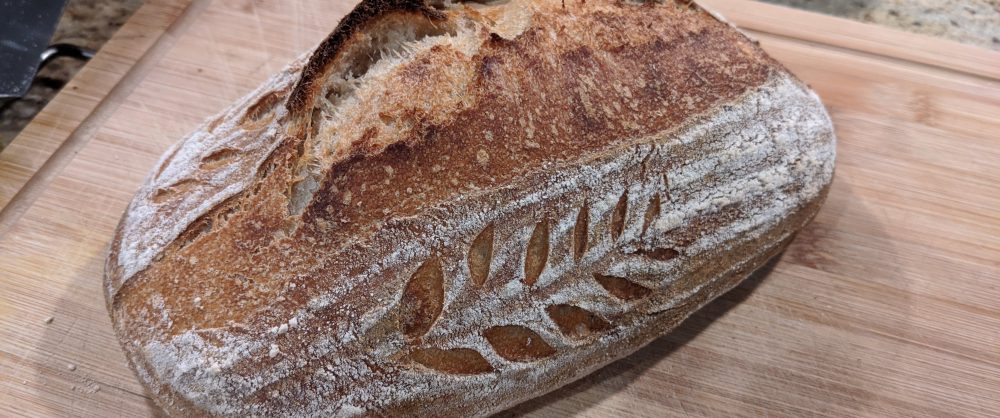Though I make lots of different bread, this is my foundational sourdough formula. The flour in the levain represents 20% of the total flour in the formula. This gives me a lot of flexibility with how mellow or how sour I want the bread as I adjust the sourness by the length of the proof. If I want a sharper tang, I will retard the finished dough for up to 36 hours. If I want just a slight tang, I’ll do a same-day bake. As I mentioned, this is my foundational formula in that it provides a platform on which I will add different add-ins or just bake it plain. I love the versatility of this dough!
But not only that, because of the hydration of the dough, I’ve even made baguettes from this dough, adding 0.75% yeast in the final dough to give it some extra oomph during final proofing. Or, I’ve even added some sugar (about 3%) to the final dough to make rolls. Like I said… versatile!
Overall Formula
| Bread Flour | 80% |
| High-Extraction Flour | 20% |
| Water | 75%* |
| Salt | 1.8% |
Levain Build
| Bread Flour | 100% |
| Water | 100% |
| Mature Starter | 20% |
Final Dough
| Bread Flour | 546g |
| High-Extraction Flour | 182g |
| Water | 500g |
| Salt | 16g |
| Levain | 364g |
| Total Yield | 1608g |
| Optimal Dough Temp | 78°F |
Make the Levain
Build a 100% hydration levain several hours before you build the final dough using some mature starter and equal parts flour and water (such as 1:5:5 ratio starter to flour and water). You’ll know the levain is ready when you see lots of bubbles on the surface of the culture – much like the bubbles that form with pancakes on griddle. This could take up to 12-16 hours to mature.
I personally use a mother culture that I keep in my fridge alongside a botanical water starter. The cool thing about using both my mother culture and the botanical water to build my starter is that the microbe density is so great, my levain is usually ready in less than 4 hours depending on the weather!
Final Dough Development
Mixing. Sift the flour and salt together and thoroughly combine. Dissolve the levain in water to make a slurry, then add it to flour-salt mixture, then mix thoroughly by hand or in a mixer on low speed until all ingredients have come together and you form a shaggy mass with no large lumps.
Bulk Fermentation: 2 1/2 to 3 hours (or more or less depending on the weather). Fold the dough twice within the first hour making sure you build good strength in the dough – it should fight you a little by the time you’re done folding. Then let it rest (covered) until it has almost doubled but don’t take it much further than that. You’ll want to leave plenty of runway for the final fermentation. For home bakers, I don’t recommend using the proof setting on your oven as it is normally too warm and things happen a bit too fast – at least for my liking.
Dividing and Shaping. Divide the dough into 800g pieces then preshape into rounds then cover and bench rest seam-side-down for 15-20 minutes until the dough has sufficiently relaxed. Shape into boules or batards and place into appropriate proofing containers.
Final Fermenation. If you want to do a same-day bake, final fermentation should be about 1 1/2-2 hours depending on the weather. The finger dent test will tell you when the loaves are ready to bake. Otherwise, let the final fermentation get started for about 30 minutes, then cover the containers and pop them in the fridge. My last batch (shown in the pictures above) took about 30 hours to get to bake-ready. But whether you do a same-day or retarded proof, you really need to have patience in this step and allow the fermentation to get to 85-90% to ensure optimum flavor development.
Bake. Score your loaves as you see fit. I use a baking stone to kind of mimic a hearth, so I bake at 500°F for 15 minutes with steam, then 425°F dry using convection for 25-30 minutes until I get a milk chocolate-brown bottom and deep-golden brown top with dark chocolate edges on the ears. If you’re using a Dutch oven, preheat your oven to 500°F, then turn it down to 475°F. Bake covered for 20 minutes, then uncovered for another 20-30 depending on how dark you want the crust.



A beautiful loaf of bread!
Thank you!
Pingback: Welcome! | The Dawg House!
Pingback: Welcome! | The Dawg House!